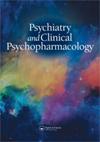抗神经元抗体和8-OHdG是自闭症谱系障碍小脑功能障碍的一个指标:一项病例对照研究
IF 0.5
4区 医学
Q4 PHARMACOLOGY & PHARMACY
引用次数: 3
摘要
目的:自闭症谱系障碍(ASD)是一种始于儿童早期的神经发育障碍,表现为社交交流领域的缺陷以及限制和重复的行为/兴趣。虽然遗传因素在其发病机制中占主导地位,但许多因素,包括神经、环境和免疫已被确定。此外,虽然小脑功能障碍在自闭症的病因学中已经在不同的研究中得到证实,但功能障碍的可能原因以及神经炎症在这些原因中的作用尚未明确。抗yo、抗hu、抗ri和抗amphiphysin抗体已被发现与小脑变性有关。本研究旨在通过ELISA方法比较ASD患者与健康儿童血液中抗yo、抗hu、抗ri、抗Amphiphysin抗体及8-OHdG值,以证明神经炎症是导致小脑功能障碍和DNA损伤的潜在原因,并评价ASD儿童儿童自闭症评定量表(CARS)评分与这些参数的关系。方法:选取连续35例根据DSM-5诊断标准就诊于哈兰大学医院儿童与青少年精神病学门诊,年龄在3 ~ 12岁之间,诊断为ASD的儿童。这些儿童没有任何慢性身体疾病,接受了幼稚治疗。33名年龄在3至12岁之间,没有任何身体或精神疾病的健康儿童被纳入健康对照组。对于精神病学评估,一种社会人口统计形式和衡量自闭症的严重程度,使用了CARS。本研究采用ELISA法检测血清中抗yo、抗hu、抗ri、抗amphiphysin抗体及8-OHdG值。结果:本研究共纳入35例自闭症患者(男性占62.9%)和33例健康对照组(男性占72.7%)(p = 0.385)。ASD组的中位年龄为6.0岁,对照组为7.0岁(p = 0.146)。ASD患者中检测到抗ri抗体阳性,而对照组未检测到抗ri抗体阳性(p = 0.002)。ASD组抗hu、8-OHdG值显著高于对照组(p < 0.001, p = 0.001);在抗yo和抗amphiphysin值方面,ASD组与对照组无显著差异(p = 0.113, p = 0.275)。结论:本研究结果提示ASD患儿可能存在抗小脑抗体,氧化应激可能导致DNA损伤。本文章由计算机程序翻译,如有差异,请以英文原文为准。
Antineuronal antibodies and 8-OHdG an indicator of cerebellar dysfunction in autism spectrum disorder: a case–control study
ABSTRACT Objectives: Autism spectrum disorder (ASD) is a neurodevelopmental disorder, that starts in early childhood and presents with deficiencies in social-communicational domains along with restricted and repetitive behaviours/interests. While genetic factors are dominant in its pathogenesis, many factors, including neurological, environmental and immunological have been identified. Furtheremore, although cerebellar dysfunction in the etiology of autism has been shown in different studies, the possible causes of the dysfunction and the role of neuroinflammation among these causes have not been clarified yet. Anti-Yo, anti-Hu, anti-Ri and anti-Amphiphysin antibodies have been found to be associated with cerebellar degeneration. The aim of the present study was to compare anti-Yo, anti-Hu, anti-Ri and anti- Amphiphysin antibodies and 8-OHdG values in blood using the ELISA method between ASD patients and healthy children to demonstrate the role of neuroinflammation as a potential cause of cerebellar dysfunction and DNA damage and evaluate the relationship between Childhood Autism Rating Scale (CARS) scores in children diagnosed with ASD and these parameters. Methods: Thirty-five consecutive children between the ages of 3 and 12 referred to the Child and Adolescent Psychiatry Outpatient Clinic of Harran University Hospital and diagnosed with ASD according to the DSM-5 diagnostic criteria were included in the study. The children did not have any chronic physical disorders and were treatment naive. Thirty-three healthy children between the ages of 3 and 12 without any physical or psychiatric disorders were included as the healthy control group. For psychiatric evaluation, a sociodemographic form and to measure the severity of autism, CARS was used. In the study, anti-Yo, anti-Hu, anti-Ri and anti-Amphiphysin antibodies and 8-OHdG values in blood were investigated using the ELISA method. Results: Thirty-five cases with autism (62.9% males) and thirty-three healthy controls (72.7% males) were included in the present study (p = 0.385). The median age was 6.0 in the ASD group and 7.0 in the control group (p = 0.146). Among ASD patients, anti-Ri antibody positivity was detected, while no anti-Ri antibody positivity was found in the control group (p = 0.002). In the ASD group, the anti-Hu and 8-OHdG values were found to be significantly higher than those of the controls (p < 0.001, p = 0.001); no significant difference was found between the ASD and control groups with regard to the anti-Yo and anti-Amphiphysin values (p = 0.113, p = 0.275). Conclusions: The results of the present study suggest that antibodies against cerebellum may be present among children with ASD and DNA damage may occur due to oxidative stress.
求助全文
通过发布文献求助,成功后即可免费获取论文全文。
去求助
来源期刊

Psychiatry and Clinical Psychopharmacology
Medicine-Psychiatry and Mental Health
CiteScore
1.00
自引率
14.30%
发文量
0
期刊介绍:
Psychiatry and Clinical Psychopharmacology aims to reach a national and international audience and will accept submissions from authors worldwide. It gives high priority to original studies of interest to clinicians and scientists in applied and basic neurosciences and related disciplines. Psychiatry and Clinical Psychopharmacology publishes high quality research targeted to specialists, residents and scientists in psychiatry, psychology, neurology, pharmacology, molecular biology, genetics, physiology, neurochemistry, and related sciences.
 求助内容:
求助内容: 应助结果提醒方式:
应助结果提醒方式:


